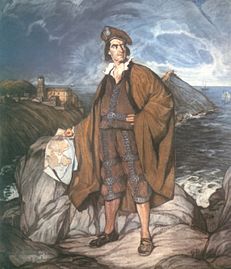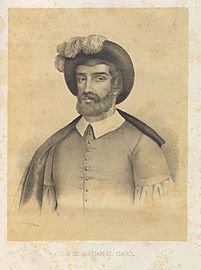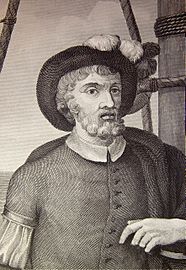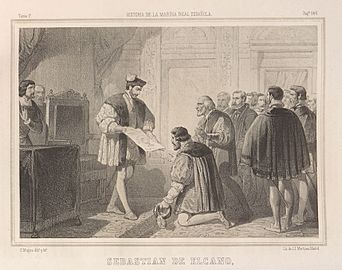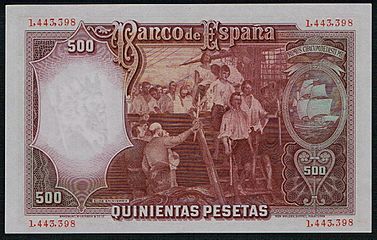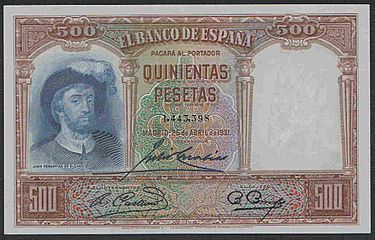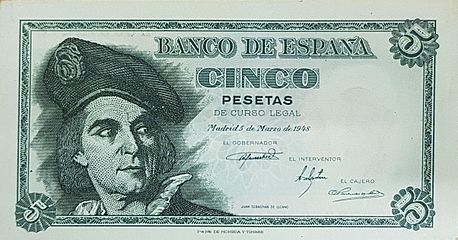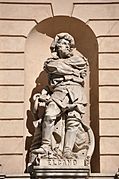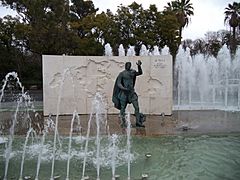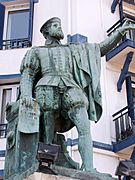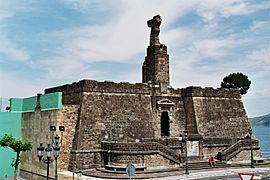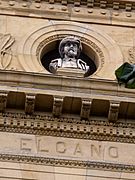Juan Sebastián Elcano facts for kids
Quick facts for kids
Juan Sebastián Elcano
|
|
|---|---|
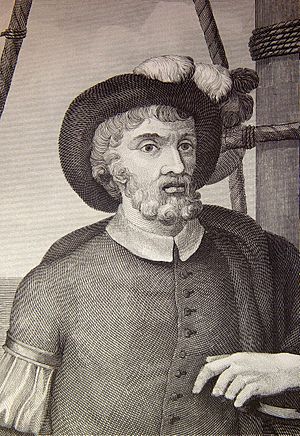
Engraving of Elcano
|
|
| Born |
Juan Sebastián Elcano
c. 1486 Getaria, Gipuzkoa, Crown of Castile
|
| Died | August 4, 1526 (aged 39–40) |
| Cause of death | Malnutrition |
| Nationality | Basque, Castilian (state) |
| Occupation | explorer, navigator and mariner |
| Known for | first circumnavigation of the earth |
| Partner(s) | María Hernández Dernialde |
| Children | Domingo Elcano III |
| Parent(s) | Domingo Sebastián Elcano I, and Catalina del Puerto |
| Relatives | Domingo Elcano II, Martín Pérez Elcano and Antón Martín Elcano |
| Signature | |
 |
|
Juan Sebastián Elcano (born around 1476 – died August 4, 1526) was a Spanish explorer. He was from the Basque region. He is famous for completing the first trip around the world. This amazing journey was started by Ferdinand Magellan.
After Magellan died in the Philippines, Elcano took charge of the expedition. He led the remaining crew and ship back to Spain. This voyage proved that the Earth is round. When he returned, the king gave Elcano his own Coat of arms. He also received a good pension for his incredible achievement.
Contents
Early Life of Elcano
Elcano was born in 1476 in Getaria, Gipuzkoa. This town is in the Basque Country of northern Spain. His parents were Domingo Sebastián de el Cano and Catalina de el Puerto. From a young age, he was a sailor and fisherman. He later worked in trading goods into French ports. In 1509, he was part of a journey against Algeria. In 1519, he was in Seville. This is where King Charles V of Spain was planning a big trip. The goal was to find a quick way to the Indies.
Magellan's Great Voyage
King Charles V chose the Portuguese navigator Ferdinand Magellan to lead this journey. The expedition had five ships and 239 men. Their goal was to find a shorter route to the Far East. They planned to go around the tip of South America. Elcano was chosen as Magellan's second-in-command.
When the expedition stopped for winter in Brazil, some of the crew rebelled. They did not want to go any further. Magellan and Elcano no longer trusted each other. Magellan blamed Elcano for the rebellion and put him in chains. One of Magellan's ships was wrecked in Brazil. By the time they reached the passage between the Atlantic Ocean and the Pacific Ocean, another ship had turned back. This passage was later named the Strait of Magellan. Magellan sailed through it in October 1520, taking a month to cross.
The three remaining ships reached Guam in March 1521. Later that month, they arrived at Homonhon Island in the Philippines. By this time, they had only 150 men left. Magellan became friends with the island's king. He soon joined a war between the king and a rival. On April 27, 1521, Magellan was killed in a battle. The remaining men and ships quickly left the Philippines. They arrived at the Spice Islands in November 1521.
By this time, Elcano was in command of the last ship of the expedition. They left the Spice Islands in December. On September 8, 1522, Elcano and his crew reached Spain. They had completed Magellan's expedition. Elcano was surprised to learn they had lost a day while traveling around the globe.
Elcano's Later Years
Elcano spent about three years in Valladolid. There, he met and fell in love with María Vidaurreta. They had a daughter together.
He later joined another expedition. This one was led by Garcia Jofre de Loaísa. Their goal was to settle the Spice Islands. They set off with seven ships and 450 men. Bad weather near Cape Horn scattered the expedition. Six of their seven ships were lost. The one remaining ship continued towards the Spice Islands.
On July 30, 1526, Loaísa died from scurvy. Scurvy is a disease caused by not getting enough vitamin C. Elcano took command of the ship. But he also died of scurvy himself on August 4, 1526.
Elcano's Place in History
For a long time, Elcano was not well-known. He was almost forgotten for about 300 years. Early stories of the voyage did not mention him much. For example, a long account by Peter Martyr d'Anghiera did not mention Elcano even once. One reason might be that the sailors who went around the world were not from noble families. They were common sailors. This did not fit with how upper classes thought back then.
The book Relazione del primo viaggio intorno al mondo by Antonio Pigafetta also did not mention Elcano. Pigafetta was a scholar who sailed with Magellan. He was one of the 18 men who survived the trip. His book made his own role seem more important. This might be why Elcano was forgotten in some histories.
However, a new idea has become popular recently. It suggests that Pigafetta did mention Elcano. But the copies of Pigafetta's work that we have today were translated from French. Since France was at war with Spain, it is thought that the French removed mentions of "Spaniards" that Pigafetta had praised. Later, a writer for King Philip II also changed the story. He made Magellan and Pigafetta seem more important. He made the common sailors seem less important.
Famous Tall Ship
A Sailing ship called Juan Sebastián de Elcano is named after the explorer. It is a very large four-masted ship. It has sailed around the Earth six times by 1986. The ship has taken part in three Operation Sail events in New York harbor. It has probably sailed more than any other major tall ship. Its home port is Cadiz, Spain. The ship is owned by the Spanish Navy.
500th Anniversary Celebration
The 500th anniversary of the first trip around the world was celebrated in Spain. This happened on September 6, 2022. To mark this special event, groups like the Elkano Foundation were created. They work to share his story and remember his journey. They also helped plan the celebration.
As part of this anniversary, a new book was published in June 2022. It is called Elcano y el País Vasco. Cómo se hizo posible la primera vuelta al mundo. The Basque Maritime Museum published it with help from the Elkano Foundation.
Elcano in Art
There are no pictures or descriptions of Elcano from his own time. All artworks showing him were made hundreds of years later. They often include things that are not historically accurate. They also show him wearing clothes from a different time.
Paintings of Elcano
-
Juan Sebastian Elcano, and his birthplace, Getaria by Ignacio Zuloaga. The man shown is actually a doctor named Pío Gogorza.
Elcano on Banknotes
-
A 500 peseta banknote from 1931. It is based on Elias Salaberria's painting.
Sculptures of Elcano
-
Inside the Palace of Gipuzkoa, Donostia.
Elcano in Movies
In 2019, an animated movie was made in the Basque language. It was directed by Ángel Alonso and called Elkano, lehen mundu bira. In 2020, another animated movie by Manuel H. Martin called El viaje más largo was shown in Seville. In 2022, Amazon Prime released a series called Boundless. In this series, Álvaro Morte played Elcano.
Images for kids
-
Nao Victoria, a replica of Elcano's ship, in Punta Arenas in southern Chile.
See also
 In Spanish: Juan Sebastián Elcano para niños
In Spanish: Juan Sebastián Elcano para niños




